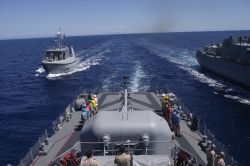WASHINGTON, May 6, 2010 — Ongoing operations in Marja, Afghanistan, are proving the Obama administration is on the right track in that country, Defense and State Department officials said today.
“Afghanistan is a work in progress, but we are turning in the right direction,” Army Brig. Gen. John W. Nicholson Jr., the director of the Joint Staff’s Pakistan-Afghanistan coordination cell, told the Senate Foreign Relations Committee.
Nicholson testified alongside David Samuel Sedney, deputy assistant secretary of defense for Afghanistan, Pakistan and Central Asia; and Frank Ruggiero, the State Department’s senior civilian representative to the military’s Regional Command South, on lessons learned from the command’s ongoing offensive in Marja.
Operations in Marja aregoing well, the officials said, due to increased troop strength, coordination with international partners such as Great Britain, having more civilian help in the area, the increasing size and effectiveness of Afghan forces, and the support of Afghan politicians.
“The Marja operations have been exemplary for its level of cooperation,” Sedney said. “This is the biggest civilian-military operation ever.”
The coalition, as of April, has half of the 30,000 additional U.S. troops in Afghanistan that President Barack Obama ordered in December and will have the rest by the end of summer, Sedney and Nicholson said in a joint prepared statement. They also expect to have 9,000 additional NATO troops from 17 nations by then, 2,000 more than were pledged in January. A hundred U.S. civilians also have been sent to work with Regional Command South to conduct the “build” phase of the “clear, hold and build” counterinsurgency strategy, the officials said.
The coalition has focused its attention on Afghanistan’s south and east, where the insurgency is the strongest, the officials said. U.S. and British troops have cleared the most densely populated areas of insurgents, Nicholson added.
Growing and increasingly effective Afghan troops, which will increase from one brigade to three by the end of summer, also are helping the effort, he said.
When Marines moved into Marja in February, one of the first things they had to do was clear it of a corrupt police force and replace it with the Afghan National Civil Order Police, which Afghans regard as more credible, Ruggiero said. Replacing the force was an example of the importance of listening to residents and local leaders, he said.
“The message from the people was very clear,” Ruggiero said. “If you are here to bring back the police force that was here before [the clearing operation], we will support the Taliban.”
Corruption remains a problem throughout Afghanistan, Nicholson acknowledged, but he noted that some Afghans support the Taliban only because they need money or are intimidated. “The enemy is not popular,” he said. “He’s dangerous, but he’s not popular.”
Marja, while not a large Afghan city, is strategically important because it was a Taliban stronghold and a world leader in poppy crops used in the illegal heroin market – a cash cow for the Taliban.
Another part of the counterinsurgency is to reintegrate low- and mid-level Taliban fighters back into society. Many low-level fighters have reintegrated, Nicholson said, and he expects more mid-level fighters to leave the insurgency as security improves.
Nicholson dismissed concerns about the effectiveness of reintegration, saying former Soviet-inspired communists and their paramilitary fighters now serve together in Afghan government roles. “Reintegration is very much something in their tradition and is attainable,” he said.
Nicholson and others said the challenge moving forward in Marja and the surrounding areas is to maintain security while providing infrastructure improvements, such as municipal services and schools, which will lead to economic prosperity.
“On the hold phase, the key task is the connection between the government and their people,” Nicholson said. “This is not a foregone conclusion in Afghanistan.” Ruggiero said his biggest concern in Afghanistan is the government’s capacity to effect such change. “This has to be done by the Afghans, and it has to be done at Afghan speed,” he said.
Source:
U.S. Department of Defense
Office of the Assistant Secretary of Defense (Public Affairs)

 von
von 